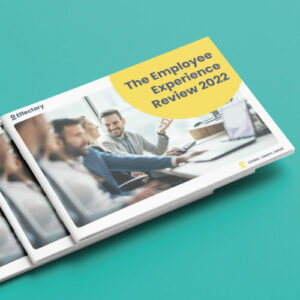An employee listening strategy offers HR a valuable opportunity to identify how properly prepared employees feel to complete their work. It gives leadership a chance to get an overview about what training and development the workforce needs in order to develop. This is especially relevant in organizations undergoing transformational change, which results in employees’ roles and responsibilities changing.
How HR can improve training and development with Employee Feedback

HR plays an important role in training and development
In this article, we’ll explore the definition of skills and competencies and outline how employee listening is essential for successfully implementing training and development initiatives.
Effectory is a leader in employee listening across the entire employee experience. Development is a very important part of the employee experience because it provides employees the opportunity to grow in their role and also progress up an organization’s hierarchy. Effectory empowers organizations to gain valuable insights about teams and individuals. Through employee listening, organizations can identify opportunities for improvements that can increase productivity and employee retention.
Download the Employee Experience Review
Discover how employees around the world are experiencing different parts of the employee journey and how this affects the employee experience.
DownloadWhat Are Skills and Competencies?
It’s important to know what the difference between “skill” and “competency” is. Let’s start by defining these two terms.
- A skill is an ability you’ve acquired through practice, training, or study. A skill is a specific technical capability, such as proficiency with particular software or hardware that enables a worker to perform a job function. Essentially, skills are what an employee can do. Skills are transferable from job to job and company to company.
- A competency, on the other hand, is an aptitude for doing something well in the real world. A competency is something more intangible—a particular way of thinking, acting, or interacting that helps workers solve problems, motivate others, and handle stressful situations effectively. Annee Bayeux, Chief Learning Strategist at Degreed, said, “Competencies tend to be big-picture and aspirational.” Competencies refer to how an employee actually performs a task. According to HRSG, “Skills + Knowledge + Abilities = Competencies”.
When hiring new employees or evaluating current employees, it’s important to look for at both their skills and competencies to sure that you get the right people for the job.
How to Improve Employee Skills and Competencies
The most effective way to improve employee skills and competencies is by providing the right training and development opportunities. Employees can benefit from effective training and development programs that help them build skills, gain knowledge, enhance performance, and contribute more effectively to the growth and profitability of your organization.
Training and development are key components in the success of any organization as they help employees develop their skills and competencies, leading to greater overall success. Some of the tools and methods used to improve employee skills and competencies include in-person and online courses, on-the-job training, mentoring, adult education, and more.
What are the Benefits of Training and Development?
Employee training and development are essential parts of any business. In today’s knowledge economy, companies that fail to invest in employee training will fall behind the competition. It is necessary to keep employees informed about new innovations in their milieu, as well as having them trained in new skills that will help the workplace perform more efficiently.
Businesses that offer comprehensive training programs have a 218% higher income per employee than those without well-developed training programs, according to the Association for Talent Development (ATD). This results in a 24% increase in profit margins.
In addition to providing workers with the skills they need to get the job done successfully each day, employee training and development:
- Enables workers to advance within the company
- Improves employee performance by enhancing personal capabilities
- Increases employee retention
- Reduces employee turnover
- Increases productivity
- Enhances job satisfaction among employees
- Encourages innovation and creativity among employees
Unfortunately, however, employee training and development still has a long way to go. Research shows that just one in ten adults feel they have “sufficient computer and Internet skills”.
Battling risks to successful digitalization
Discover global insights into battling risks to successful digitalization. We identify the five most common leadership gaps that management needs to address in order to fully profit from organizational transformation.
DownloadWhat are Training and Development?
Employee training is an organized effort to improve employee knowledge or skillsets by providing information, experience, or instruction. Training can be provided in a number of ways, from on-the-job coaching to classroom instruction to reading materials that can be studied independently.
- Formal training involves a planned learning activity that takes place in a classroom or online environment where an instructor delivers information using digital presentations and other teaching aids.
- Informal training is similar to formal training except that the development activity occurs outside of a classroom or online environment with no dedicated instructors present. Informal forms of training include mentoring, self-paced computer-based courses, participation in professional conferences, and reading books related to your profession.
The methods used will depend on the type of employees you have, the nature and scope of your business, and what skills are needed for optimal performance.
Development, on the other hand, is about improving personal or professional competence; it encompasses both training and professional experience.
Use Employee Listening to Find out What Skills and Competencies Your Workforce Needs
Employee listening is about hearing the voices of employees and using their experiences and expertise to drive business growth. An organization which is open to employee feedback fosters a culture of communication, participation and engagement.
Employee listening helps organizations understand the needs, wants, concerns and desires of their employees. It also creates awareness among the company’s leadership about what employees value most in the workplace.
Organization find value in supporting their employees developing their skills. For this to be successful there must be a clear understanding of expectations, a way to track progress, and ongoing support. The following are best practices that you should consider when managing an employee’s training and development.
- Open the dialogue. Create a space for employees to be comfortable sharing their thoughts on their potential training and development opportunities.
- Identify the skill areas that need improving. Before considering training and development options, it’s important to establish which skills need to be improved.
- Identify the available training options. There are many types of training options available depending on company size and budget, these can range from online education courses all the way up to formal college certifications or degrees. You will have many options available, so it is important that you determine what resources you have at your disposal before investing in training or education programs.
- Track progress. Finally, it’s critical to make sure training is monitored so that it can be assessed and adjusted as needed. Some employees might need more or less time with a particular training program or a different level or type of assistance in order to achieve success. Be flexible and adaptable in order to help your employees succeed and be willing to translate employee feedback into action.
How can you identify which skills and competencies need improving? Ask the right questions in order to get information about what will be most beneficial for an employee’s progress. Start by asking what kinds of issues or problems they run into frequently. This may include misunderstanding instructions, as inability to complete tasks in a timely manner, or difficulty using certain software.
Effectory’s employee listening platform allows organizations to survey employees. With Effectory, HR can identify how well trained employees feel, or which skill areas require improvement.
Book a free demo. See our solutions in action.
Effectory is Europe's Leading provider of Employee Listening Solutions. Schedule a product demo and discover how to enhance your employees' engagement.
Demo request

